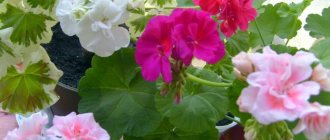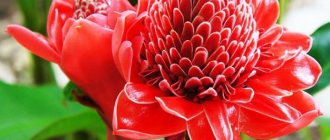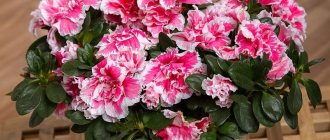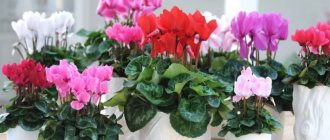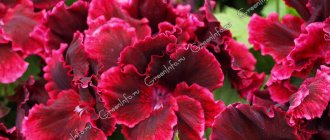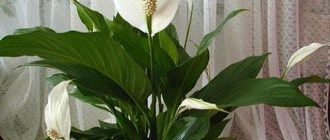Geranium does not bloom: reasons and what to do: Pixabay Geranium is valued for its lush flowering, which lasts for several months. If it does not bloom, then, most likely, the conditions of maintenance and the rules of caring for the plant have been violated. The advice of expert flower growers Tatyana Doroshenko, Daria Rezko and Irina Pigulevskaya will help you understand the reasons for the lack of flowering and correct the situation.
Features of flowering
Flowering is a method of reproduction. During the period of swelling of flower buds, the formation of flowers, and the formation of pollen, pelargonium (and all plants) consumes the greatest amount of energy, and the processes of metabolism and absorption of useful substances are accelerated.
When and for how long does the plant bloom?
With proper care, pelargonium blooms up to 6 times per season, from spring to late autumn, opening buds again and again, which remain decorative for 20 days. The bush remains attractive for up to 5 years, and with proper care, including proper pruning and dormant periods, it can remain decorative for 10 years.
Pelargonium diseases and their treatment
As a rule, improper care causes houseplant diseases. Most often, pelargonium is affected by the following diseases:
- Blackleg - the cause of the disease is improper care, soil contamination or excess moisture. The stem of the plant is the first to be affected, so if the disease is detected in time, pelargonium can be saved. When replanting, it is not recommended to use old soil.
- Mold - a fungus that affects the leaves of an indoor flower. To save the plant it is necessary to treat it with a fungicide. In the future, ensure proper care - regularly ventilate the room and do not allow the soil to become waterlogged.
- Aphids and whiteflies are pests that attack the lower part of plant leaves, so it is not always possible to identify them in time. To get rid of pests, spray pelargonium with special chemicals containing permethrin.
Pelargonium is a favorite indoor plant for many, and if you provide it with proper care, it will delight the eyes of those around you with lush greenery and bright flowers.
The necessary conditions
For long and abundant flowering, several conditions must be met:
- Comfortable temperature for flowering pelargonium is 22–27 degrees.
- The plant prefers tight pots with light, water- and breathable soil.
- The flower loves a lot of light, bright but diffused.
- Does not tolerate stagnant moisture; watering is rare, but abundant and regular. Between waterings, the soil ball should dry out by half.
- You should regularly pick off wilted inflorescences and yellow leaves.
- At the beginning of growth, pinch over the fifth leaf of each shoot to ensure proper formation of the bush.
- Do not overfeed with nitrogen fertilizers; potassium and phosphorus are preferable for flowering.
- Daylight hours during this period should be 12–14 hours.
Spraying the leaves is not recommended. In winter, the plant should be at rest at a temperature of 10–14 degrees. in order to accumulate strength for the next seasonal flowering. If there is no dormant period, the number of inflorescences decreases and the flowers become smaller. The bush loses its decorative effect.
Pelargonium propagation
Large-flowered pelargonium is propagated using seeds, dividing the bush and cuttings.
Each method has its own characteristics, let’s consider them in more detail.
Cuttings
The favorable time of year for this type of reproduction is considered to be the beginning of spring and the end of summer. To do this, you need to cut cuttings 5-7 cm long from an adult plant, wither them a little and only then put them in a container with water. After the roots appear, the young plant can be planted in the ground.
Seed propagation
The ideal time for this method of propagation is winter. The seeds of the plant are laid out on moist soil and covered a little with soil, after which it is necessary to cover the pot with polyethylene. Before emergence, the container must be kept at a temperature of at least 20-24 degrees. If care is correct and regular, shoots will appear in a few weeks. After they appear, it is recommended to place the pots in a cooler and well-lit place. After a few months, young plants can be planted in pots.
How to care?
Caring for the beautiful pelargonium is not difficult, but it must be done regularly.
Caring for a plant includes several mandatory conditions:
- do not overdo it with watering;
- carry out timely pruning;
- observe a rest period in winter;
- feed regularly in spring and summer;
- observe light and temperature conditions.
Watering
From spring to autumn, you need to water the flower when the clod of earth is half dry, this is approximately once every 7-10 days, without touching the leaves and flowers. Excess water from the pan should be removed. No need to spray. If the air in the room is dry, place a bowl of water next to the pot. In winter, water only when the soil is completely dry.
Do not use hard water for irrigation. Replace with boiled or bottled water.
Light mode
From spring to early autumn, pelargonium should be placed on southern and south-eastern windows. Daylight hours are 12–14 hours. In this case, direct sun should be avoided. The light should be diffused . To do this, you need to move the pots a meter from the window and shade the flowers with transparent curtains. In winter it is a bright place with short daylight hours.
Feeding
After planting, pelargonium can be fed with nitrogen fertilizers so that the bush increases its biomass. During the flowering period, it should be fed 3 times a month with potassium-phosphorus fertilizers. You can use a fertilizer produced specifically for pelargoniums or for flowering plants. In winter, the plant does not need to be fertilized.
Temperature
Spring – summer – early autumn, when pelargonium blooms, the optimal temperature is 22–27 degrees. In winter, at rest, 10–15 degrees.
Trimming and pinching
Before winter, pruning or pinching should be done. As a rule, young plants are pinched. This is done like this: the top of each shoot is pinched or cut off so that 5 leaves remain on the shoot. Bushes older than 2 years are regularly pruned. This is a very important procedure for abundant flowering:
- forms a beautiful bush;
- increases the number of inflorescences;
- prolongs flowering time.
Pelargonium is trimmed immediately after flowering in two ways:
- up to the 7th dormant bud;
- up to 3 buds, that is, per stump.
The choice of method depends on the condition of the bush. Young bushes can be pinched up to the 7th bud. Bushes that have become woody are pruned into a “stump.”
Before pruning, the plant should not be watered so that juices do not ooze from the cuts. Disinfect the cut areas with brilliant green or charcoal. After pruning, do not water for 1-2 days, then water and place in a bright place. The plant may have to be pinched in the spring; during the winter, if there is insufficient light, it may stretch out.
Rest period
Pelargonium is at rest from December to early spring. She does not need feeding at this time. During this period, plants are watered only when the earthen ball dries out completely. Pelargonium grows well and develops in winter, growing branches and leaves. The temperature should be at least 7 degrees, there is a lot of light, the daylight hours are short.
Care
When geranium blooms, you need to properly care for it.
Despite the fact that the crop prefers a large amount of sunlight, it should be placed in shaded areas in the summer.
Caring for geraniums will prevent the appearance of yellow spots on the bushes.
Promptly remove dry leaves and young shoots that will form from the root system. Watering should be done at intervals of 4 days.
Water should spread well throughout the soil and not accumulate in one place. This can cause root rot. Watering is carried out after the soil has dried.
Loosen the soil weekly to saturate it with oxygen.
Why does the crop produce only foliage at home: reasons
Pelargonium is unpretentious, but under some circumstances it does not form buds and does not bloom. What's the matter?
- Pot too big. Pelargonium, planted in a large container, gives itself the command to grow roots to fill the free space with them, and it will spend all its energy only on this. You can plant several plants in a large pot so that they are crowded and compete with each other, then flowering will begin quickly.
- Lack of fertilizing. The soil in the pot is quickly depleted. Regular feeding is required for lush flowering. Balanced fertilizers can be purchased at the store. The bush should be fertilized up to 3 times a month. The flower responds well to feeding with iodine: 1 drop per liter of soft water. 50 ml of solution per feeding.
- Overmoistening of the soil. The flower cannot stand this, the roots begin to rot. The plant may shed its leaves or even die.
- The soil is not suitable. Pelargonium cannot develop normally in heavy, clayey soils that retain water for a long time. The soil should be light, permeable, with a neutral acidity level. It is best to use ready-made substrate for pelargoniums from the store.
- Improper wintering conditions can prevent flowering. During the dormant period, temperature and light conditions should be observed so that the plant can gather its strength.
- No trimming. This procedure stimulates long and lush flowering. It should be held every autumn.
- Without replanting for more than 2–3 years, the plant will refuse to bloom.
- Lack of light and length of daylight hours is one of the important factors for the lack of flowers.
Planting geraniums in open ground
Indoor geraniums are positively affected by planting in open ground. Such manipulations are not only useful, but will also improve the garden, plot and flower bed. To ensure that changing the habitat does not harm the plant, it must be done wisely.
To improve the quality of the flower, it is important to choose the right planting season. The procedure is not carried out during the period of active flowering (summer). Pelargonium does not tolerate sudden changes in temperature; this can easily lead to the death of the plant.
The most suitable time is spring. Autumn planting does not make sense, since the onset of frost is just around the corner, and the flower will not even have time to take root.
Geranium loves warmth and plenty of sunlight. Places are chosen with good lighting; it is advisable that the access to the sun is not blocked by other large plants.
The soil in the open ground should be identical to that present in the pot. The presence of sand and a drainage layer is desirable. Pelargonium does well in humid air. For the purpose of additional saturation with moisture, sphagnum moss is placed near the flower.
Please note that shoots and roots of pelargonium grow quickly in the wild. This feature should be taken into account when replanting the plant in a flowerbed.
After pelargonium has been in the open ground, it is returned to the house without waiting for cold weather. In winter, the plant is provided with rest, watering is minimized and the temperature is reduced. Such manipulations benefit the geranium and promote flowering in the future.
What to do to make it bloom profusely?
In order to force pelargonium to bloom, it should be placed in conditions under which it will be forced to form buds, creating a stressful situation for it. First you need to analyze the conditions in which the flower grows, the shortcomings must be eliminated.
If the lack of flowering is not clear, there are several stress techniques to stimulate pelargonium flowering :
- Radical pruning . This measure allows you to increase the number of side shoots and stimulates the formation of flower buds.
- Temperature stress . Take the flower to the balcony or plant it in the garden so that there is a difference between day and night temperatures.
- Feeding with iodine . This is the simplest and most economical way to provoke pelargonium to bloom. For 1 liter of water, 1 drop of iodine (alcohol solution from a pharmacy). Florists advise dissolving iodine in heated water. The solution is thoroughly mixed. 50 ml of the solution is added to the already moist soil of the pot, away from the roots, closer to the walls. This procedure should be carried out once every 3-4 weeks.
- Transplant . This procedure stimulates flowering well. The correct selection of pot, soil, as well as placing the flower in a dark place after transplantation for 1-2 days will force the formation of buds.
Nowadays, varieties of pelargonium of compact shapes, with flowers of various shades, have been developed. If the necessary conditions are created and regular care is taken, the flower will delight you with lush blooms from spring to late autumn.
Aftercare
Proper and long-term care of geraniums is important.
To do this, follow these rules:
- Apply complex fertilizers at the root, from which you need to prepare a water-based solution.
- Peduncles that have dried out must be carefully removed.
- Water the plants every 3-5 days.
- In autumn, place the pot of geranium in a cool place where the temperature will range from +7°C to +12°C. This will allow the plant to gain strength.
As you can see, there are many reasons why geraniums do not bloom. If you care for it properly, it will decorate your home or garden with beautiful bright flowers. Monitor the state of the culture and correct mistakes in a timely manner. Choose beautiful varieties for yourself based on photos and names and enjoy the color variety on the site.
